Diplomatic Bluebook 2024
Opening Special Feature
G7 Hiroshima Summit 2023 From Hiroshima to the World -Toward a World Characterized by Cooperation and Peace, Not Division and Confrontation-
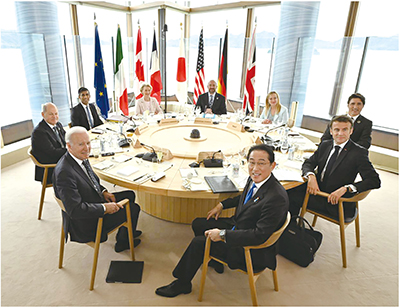 Session 1 of the G7 Hiroshima Summit (May 19, Hiroshima Prefecture)
Session 1 of the G7 Hiroshima Summit (May 19, Hiroshima Prefecture)The G71 shares the fundamental values and principles of freedom, democracy, human rights and the rule of law, and has jointly demonstrated leadership in addressing issues faced by the international community. As the holder of the G7 Presidency, Japan held the G7 Hiroshima Summit2 in Hiroshima Prefecture from May 19 to 21. Japan led the discussions among the leaders at the Summit and demonstrated proactive initiatives to steadily implement the outcomes of the Summit and address further challenges.
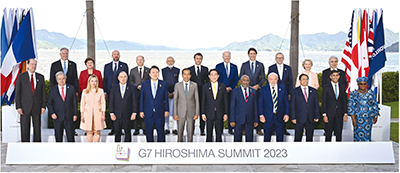 ▲Group photo (G7 leaders, invited country leaders, heads of international organizations) (May 20, Hiroshima Prefecture)
▲Group photo (G7 leaders, invited country leaders, heads of international organizations) (May 20, Hiroshima Prefecture)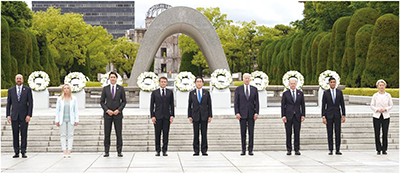 ▲G7 Leaders after they offered flowers to the Cenotaph for the Atomic Bomb Victims (May 19, Hiroshima Prefecture)
▲G7 Leaders after they offered flowers to the Cenotaph for the Atomic Bomb Victims (May 19, Hiroshima Prefecture)- 1 The G7 is a framework with participation by seven countries (France, the United States (U.S.), the United Kingdom (UK), Germany, Japan, Italy, Canada (in order of presidency)), and the European Union (EU). G7 meetings are sometimes attended by invited countries and international organizations other than G7 members. The G7 Hiroshima Summit was attended by Australia, Brazil, Comoros (Chair country of the African Union (AU)), Cook Islands (Chair country of the Pacific Islands Forum (PIF)), India (G20 Presidency), Indonesia (ASEAN Chairmanship), the Republic of Korea (ROK), Viet Nam, the United Nations (UN), International Energy Agency (IEA), the International Monetary Fund (IMF), the Organization for Economic Cooperation and Development (OECD), the World Bank, the World Health Organization (WHO) (online participation), and the World Trade Organization (WTO). (*In addition, Ukraine participated in some sessions.)
- 2 G7 Hiroshima Summit homepage: https://www.mofa.go.jp/policy/economy/summit/hiroshima23/en/

1 G7 Hiroshima Summit (May)
(1) Overview
At the G7 Hiroshima Summit, under the broad theme of realizing an international community characterized by cooperation, not division and confrontation, the G7 demonstrated active and concrete contributions with the two pillars of upholding the free and open international order based on the rule of law and strengthening outreach with international partners beyond the G7. The Indo-Pacific was also an important theme throughout the various topics of discussion.
G7 leaders, together with invited countries and organizations, discussed a variety of issues facing the international community, including food, development, health, climate change and energy, and the environment, and affirmed the importance of cooperating with developing and emerging countries in the so-called the Global South to address these issues. In addition, the leaders of G7, invited countries, and Ukraine discussed global peace and stability, and shared recognition of the importance of the principles of the United Nations (UN) Charter, including the rule of law as well as respect for sovereignty and territorial integrity.
(2) Outcomes and Follow-up Status of Major Fields
(A) Situation in Ukraine
At the G7 Hiroshima Summit, G7 leaders confirmed that they would continue to impose severe sanctions against Russia and provide strong support for Ukraine, and issued the G7 Leaders' Statement on Ukraine. In addition, Ukrainian President Volodymyr Zelenskyy participated in-person in relevant sessions and met with Prime Minister Kishida and other leaders.
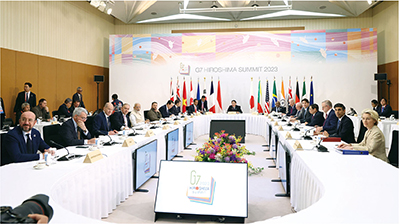 Session 9 of the G7 Hiroshima Summit, “Toward a Peaceful, Stable and Prosperous World” (May 21, Hiroshima Prefecture; Photo: Cabinet Public Affairs Office)
Session 9 of the G7 Hiroshima Summit, “Toward a Peaceful, Stable and Prosperous World” (May 21, Hiroshima Prefecture; Photo: Cabinet Public Affairs Office)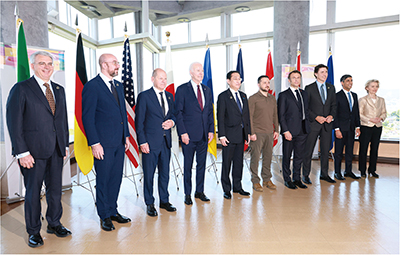 Group photo with President Zelenskyy of Ukraine during Session 8 “Ukraine” of the G7 Hiroshima Summit (May 21, Hiroshima Prefecture; Photo: Cabinet Public Affairs Office)
Group photo with President Zelenskyy of Ukraine during Session 8 “Ukraine” of the G7 Hiroshima Summit (May 21, Hiroshima Prefecture; Photo: Cabinet Public Affairs Office)At the G7 Leaders' Video Conference on December 6, which was also attended by President Zelenskyy in the beginning, Prime Minister Kishida stressed that the G7 remained committed to leading the international community's response to Russia's aggression against Ukraine, even as the situation in the Middle East grew increasingly tense. He also demonstrated the G7's determination to unite and continue to strongly promote sanctions against Russia and support for Ukraine, in order to achieve a just and lasting peace.
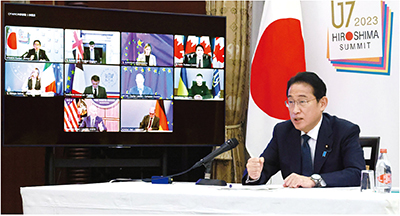 Prime Minister Kishida speaks at the G7 Leaders' Video Conference (December 6, Tokyo; Photo: Cabinet Public Affairs Office)
Prime Minister Kishida speaks at the G7 Leaders' Video Conference (December 6, Tokyo; Photo: Cabinet Public Affairs Office)(B) Indo-Pacific
At the G7 Hiroshima Summit, Prime Minister Kishida explained Japan's New Plan for a “Free and Open Indo-Pacific (FOIP)”3 and stated that the G7 would strengthen cooperation with the Indo-Pacific region, including ASEAN countries and Pacific Island countries. G7 leaders confirmed that they would continue to closely cooperate in addressing issues concerning China and also responding to North Korea, including the nuclear and missile issues and the abductions issue.
- 3 On March 20, Prime Minister Kishida delivered a policy speech entitled “The Future of the Indo-Pacific─Japan's New Plan for a ‘Free and Open Indo-Pacific' ─ ‘Together with India, as an Indispensable Partner.'” In it, he announced the New Plan for FOIP, which launches the four pillars of cooperation for FOIP: “Principles for Peace and Rules for Prosperity,” “Addressing Challenges in an Indo-Pacific Way,” “Multi-layered Connectivity,” and “Extending Efforts for Security and Safe Use of the Sea to the Air.”
(C) Disarmament and Non-Proliferation
The G7 Summit was held in Hiroshima, which was devastated by atomic bombing and is now a symbol of the pledge for peace. The Summit had historic significance in confirming the commitment of G7 leaders and others to realize a world without nuclear weapons. The leaders of the G7 learned firsthand the reality of the atomic bombing and solemnly shared a moment to sense, and planted a tree to show to the world their strong determination for the future to ensure that the catastrophes of nuclear weapons will never occur again. In addition to G7 leaders, the leaders of the invited countries and heads of international organizations shared a time of solemn remembrance by having a first-hand look at the reality of the atomic bombing and the thoughts of people who wish for peace through offering flowers at the Peace Memorial Park, visiting the Peace Memorial Museum, and listening to the voices of atomic bombing survivors. This is reflected in the messages that the leaders wrote in the guest book.
G7 leaders reaffirmed their commitment to a world without nuclear weapons, issued the “G7 Leaders' Hiroshima Vision on Nuclear Disarmament,” the first stand-alone G7 leaders' document on nuclear disarmament, and once again strengthened the momentum of the international community toward a world without nuclear weapons.
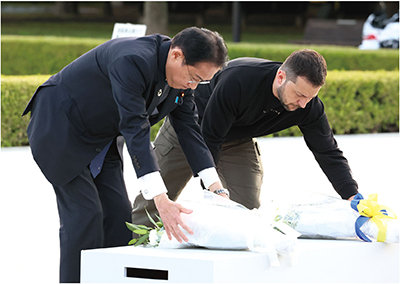 Prime Minister Kishida and President Zelenskyy of Ukraine offer flowers at Peace Memorial Park (May 21, Hiroshima Prefecture)
Prime Minister Kishida and President Zelenskyy of Ukraine offer flowers at Peace Memorial Park (May 21, Hiroshima Prefecture) Message in the Peace Memorial Museum guest book written by President Joseph Biden of the United States
Message in the Peace Memorial Museum guest book written by President Joseph Biden of the United States“May the stories of this Museum remind us all of our obligations to build a future of peace. Together-let us continue to make progress toward the day when we can finally and forever rid the world of nuclear weapons. Keep the faith!”
*See the Ministry of Foreign Affairs website for leader's message:
https://www.mofa.go.jp/policy/economy/summit/hiroshima23/en/topics/detail014/

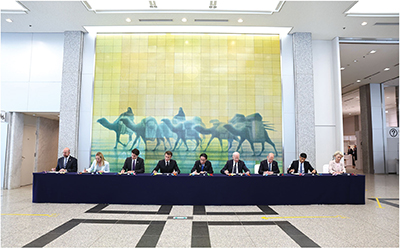 G7 leaders writing in the guest book after visiting the Peace Memorial Museum (May 19, Hiroshima Prefecture)
G7 leaders writing in the guest book after visiting the Peace Memorial Museum (May 19, Hiroshima Prefecture)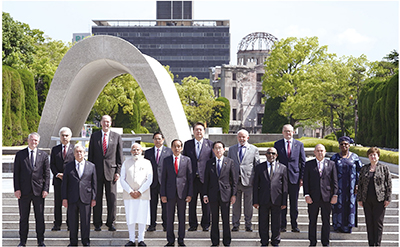 Group photo with leaders of invited countries and heads of international organizations who visited Peace Memorial Park (May 21, Hiroshima Prefecture)
Group photo with leaders of invited countries and heads of international organizations who visited Peace Memorial Park (May 21, Hiroshima Prefecture)(D) Food Security
At the G7 Hiroshima Summit, G7 leaders committed to continuing their efforts to improve global food security, taking into account the negative impacts of Russia's aggression against Ukraine on global food security. The leaders of the G7 and invited countries also jointly issued the Hiroshima Action Statement for Resilient Global Food Security. They shared the importance of working closely together to respond the food security crisis outlined in the statement and to take medium- to long-term actions with partner countries to build resilient, sustainable, and inclusive agriculture and food systems, and called for broader cooperation within the international community.
Based on the statement, Japan co-hosted the Dialogue on the Food Security Crisis between Food Exporting Countries and Importing Countries with the International Grains Council in London in the United Kingdom (UK) in June. The outcome document of the discussion was announced at a high-level event co-hosted by Japan, Italy, the United Arab Emirates (UAE), and the Food and Agriculture Organization of the United Nations (FAO) during the UN General Assembly High-Level Week in September.
(E) Economic Resilience and Economic Security
At the G7 Hiroshima Summit, a standalone session on economic security was held for the first time at a G7 Summit. During the session, G7 leaders affirmed that the G7 would be united in responding to issues such as (1) enhancing resilience of supply chain and critical infrastructure, (2) strengthening its response to non-market policies and practices and economic coercion, and (3) appropriately managing critical and emerging technologies. In addition, based on the recognition that economic security is a strategic challenge that the G7 should closely cooperate and tackle, G7 leaders confirmed their will to closely coordinate in a holistic manner through the G7 framework. In particular, with regard to economic coercion, G7 leaders confirmed the launch of the Coordination Platform on Economic Coercion. As the first comprehensive and concrete message on economic resilience and economic security as the G7, G7 leaders issued the G7 Leaders' Statement on Economic Resilience and Economic Security. Furthermore, the leaders issued the “G7 Clean Energy Economic Action Plan” on supply chain resilience for the clean energy transition.
Based on these outcomes, at the G7 Trade Ministers' Meeting in Osaka-Sakai on October 28 and 29, the participants concurred to make further progress on economic coercion as the G7, and also concurred on the need to strengthen cooperation with the wider international community and engagement with the private sector for supply chain resilience.
In addition, during the G7 Leaders' Video Conference on December 6, Prime Minister Kishida called for stronger cooperation among the G7 in this area in the future, pointing out the need to strengthen cooperation in addressing non-market policies and practices and economic coercion, strengthening supply chains and key infrastructure, and managing sensitive technologies, and noting that the discussions at the G7 Hiroshima Summit and the G7 Leaders' Statement on Economic Resilience and Economic Security are the foundation for that.
(F) Climate and Energy
At the G7 Hiroshima Summit, G7 leaders confirmed that the G7, Pacific Island countries, African countries, and countries of other region need to work together on climate change, which is an urgent issue that is common to all humanity and should be called the “climate crisis.” The leaders also called on all major economies to peak global greenhouse gas (GHG) emissions by 2025 in order to achieve the 1.5°C target4 for limiting temperature rise. The participants also affirmed their common understanding of the importance of pursuing the common goal of net zero emissions under various pathways that utilize all technologies and energy sources according to each country's situation, so as not to impede economic growth, while maximizing the use of renewable energy and energy efficiency while holistically addressing energy security, the climate crisis, and geopolitical risks. They also confirmed the importance of mobilizing climate finance and the need to support countries and peoples vulnerable to climate change.
Furthermore, G7 leaders called on the International Energy Agency (IEA) to (1) make recommendations on options on how to diversify supplies of energy and critical minerals as well as clean energy manufacturing, (2) develop a clean energy manufacturing roadmap, and (3) convene an international forum with relevant parties from the public sector, finance, corporate, research and start-ups. In response to this request, a recommendation on how to diversify the supply of energy and critical minerals as well as clean energy manufacturing was released by the IEA in December.
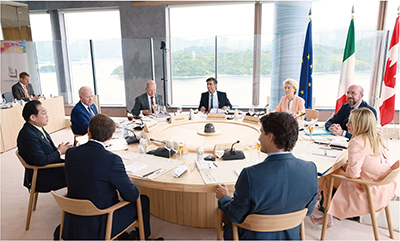 Prime Minister Kishida attends Session 5 “Economic Resilience and Economic Security” of the G7 Hiroshima Summit (May 20, Hiroshima Prefecture)
Prime Minister Kishida attends Session 5 “Economic Resilience and Economic Security” of the G7 Hiroshima Summit (May 20, Hiroshima Prefecture)- 4 This goal was set through the Paris Agreement, aiming to limit the global average temperature increase to well below 2°C above pre-industrial levels, and continue efforts to limit the increase to 1.5°C above pre-industrial levels.
(G) Environment
At the G7 Hiroshima Summit, G7 leaders welcomed the adoption of the Kunming-Montreal Global Biodiversity Framework (GBF), a new framework for biodiversity conservation, and committed to its swift and full implementation and achievement of each of its goals and targets. G7 Leaders also confirmed their commitment to end plastic pollution with the ambition to reduce additional plastic pollution to zero by 2040.
(H) Global Health
At the G7 Hiroshima Summit, Prime Minister Kishida called for addressing global health challenges, including preparing for the next crisis after the COVID-19. G7 leaders confirmed their commitment to improve global health governance, further promote funding initiatives, and strengthen international norms in order to develop and strengthen the global health architecture (GHA) for enhanced prevention, preparedness, and response (PPR) to public health crises. In addition, to contribute to the achievement of more resilient, equitable, and sustainable universal health coverage (UHC),5 the G7 pledged to contribute more than 48 billion U.S. dollars from both the public and private sectors, and Japan expressed its intention to contribute 7.5 billion U.S. dollars between 2022 and 2025. Furthermore, with regard to the promotion of health innovation, which is key to strengthening GHA and achieving UHC, the G7 announced “the G7 Hiroshima Vision for Equitable Access to Medical Countermeasures (MCMs),” which outlines basic ideas and principles for ensuring equitable access to MCMs, and launched “the MCM Delivery Partnership for equitable access (MCDP).”6 In addition, during the UN General Assembly in September, Prime Minister Kishida attended the UN General Assembly High-Level Meeting on UHC and Foreign Minister Kamikawa attended the UN High-Level Meeting on Pandemic PPR. Japan also hosted the G7 Health Follow-up Side Event, and reaffirmed its commitment to achieve UHC and strengthen PPR with the G7, relevant countries, international organizations, and others.
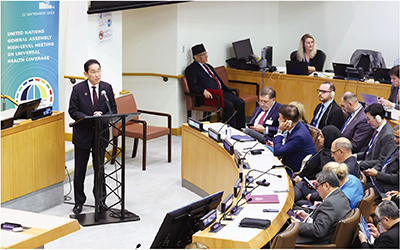 Prime Minister Kishida attends the UN General Assembly High-Level Meeting on UHC (September 21, New York, U.S.; Photo: Cabinet Public Affairs Office)
Prime Minister Kishida attends the UN General Assembly High-Level Meeting on UHC (September 21, New York, U.S.; Photo: Cabinet Public Affairs Office)- 5 Universal Health Coverage (UHC): All people can receive basic health services when they need them at an affordable cost without financial hardship.
- 6 MCM Delivery Partnership for equitable access (MCDP): A framework for international cooperation focusing on MCM delivery to ensure equitable access to MCMs as a countermeasure in the event of infectious disease crises.
(I) Gender
Throughout the year of its G7 Presidency, Japan stressed the importance of integrating policies on various issues to promote gender mainstreaming, and at the relevant G7 ministerial meetings, gender equality and the empowerment of women and girls in all their diversity were discussed. The “nexus approach” was advocated to further advance gender mainstreaming into various policy areas, which was clearly stated in the G7 Hiroshima Leaders' Communiqué. The nexus approach emphasizes organic linkages among policies. The concept is that it is important to jointly cooperate and coordinate policies and work together in an integrated manner, so that synergistic effects can be generated, and progress can be expected toward the achievement of gender equality.
At the G7 Hiroshima Summit, Prime Minister Kishida emphasized the importance of creating a “nexus” to promote gender mainstreaming, and stated that various initiatives will be organically coordinated, using as examples the promotion of the Women, Peace and Security (WPS)7 Agenda, including its application to disaster risk reduction, as well as women's economic independence. The participating countries and organizations expressed their agreement.
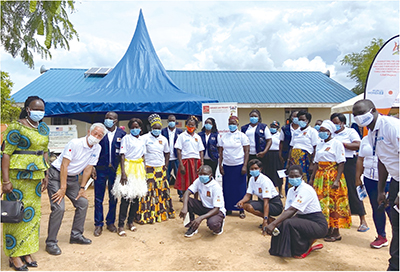 Example of Japanese support project to promote WPS: Women's Leadership, Empowerment, Access and Protection (Women LEAP) Center in Bidibidi refugee community (August 25, 2021, Uganda)
Example of Japanese support project to promote WPS: Women's Leadership, Empowerment, Access and Protection (Women LEAP) Center in Bidibidi refugee community (August 25, 2021, Uganda)- 7 Women, peace, and security (WPS): An approach in which amidst protecting women, women themselves can help move closer to a more sustainable peace by taking leadership positions and participating in conflict prevention, reconstruction, and peacebuilding. In 2000, for the first time in its history, the UN Security Council passed Security Council resolution 1325 on WPS, which clearly states that international peace and conflict prevention and resolution require the equal participation of women, protection against sexual violence during conflicts, and gender equality.
(J) Development
At the G7 Hiroshima Summit, G7 leaders confirmed that they would promote efforts for effective utilization of development cooperation and mobilization of private-sector funds, taking into account that 2023 was the midpoint year toward achieving the Sustainable Development Goals (SDGs).
In addition, during the G7 Hiroshima Summit, Japan also hosted a side event on the Partnership for Global Infrastructure and Investment (PGII), inviting the private sector for the first time. At the event, the G7 expressed its commitment to mobilizing private sector capital for infrastructure investment in partner countries in collaboration with a wide range of stakeholders. Prime Minister Kishida introduced the PGII initiatives and Japan's efforts under the partnership and stated that Japan has been promoting infrastructure investment around the world, including in Asia, Africa, and the Pacific, to mobilize more than 65 billion U.S. dollars in infrastructure assistance and private capital over the next five years, and that Japan will work to further promote investment in high quality infrastructure.
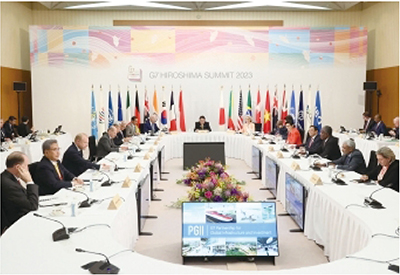 Side-event on the Partnership for Global Infrastructure and Investment (May 20, Hiroshima Prefecture)
Side-event on the Partnership for Global Infrastructure and Investment (May 20, Hiroshima Prefecture)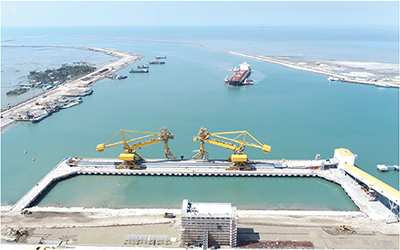 Example of Japan's PGII initiatives: Construction site of the Matarbari port development project (Matarbari, Bangladesh; Photo: Coal Power Generation Company Bangladesh Limited)
Example of Japan's PGII initiatives: Construction site of the Matarbari port development project (Matarbari, Bangladesh; Photo: Coal Power Generation Company Bangladesh Limited) Example of Japan's PGII initiatives: Construction site for the Delhi rapid transport system construction plan (Delhi, India; Photo: Delhi Metro Rail Corporation Limited)
Example of Japan's PGII initiatives: Construction site for the Delhi rapid transport system construction plan (Delhi, India; Photo: Delhi Metro Rail Corporation Limited)(K) Digital and Artificial Intelligence (AI)
At the G7 Hiroshima Summit, G7 leaders affirmed the need for governance on generative AI and immersive technologies (such as the metaverse) in line with G7 values and launched the Hiroshima AI Process for discussion on generative AI. G7 leaders also endorsed the establishment of the Institutional Arrangement for Partnership (IAP) for operationalising Data Free Flow with Trust (DFFT).
Through the Hiroshima AI Process, the Hiroshima AI Process Comprehensive Policy Framework, including the Hiroshima Process International Guiding Principles for All AI Actors and the Hiroshima Process International Code of Conduct for Organizations Developing Advanced AI Systems, was agreed at the G7 Digital and Tech Ministers' Meeting on December 1, and then endorsed at the G7 Leaders' Video Conference on December 6. This was a landmark achievement that comprehensively set out the rules on AI to be followed by the relevant actors for the first time globally, and clearly demonstrated to the world that the G7 responded effectively and quickly to the governance of rapidly evolving generative AI.
At the same G7 Digital and Tech Ministers' Meeting, ministers adopted the G7 Digital and Tech Ministers' Statement on Operationalisation of Data Free Flow with Trust and an annex outlining the organization details of the IAP, and affirmed the progress of efforts related to the IAP.
(L) Trade
At the G7 Hiroshima Summit, the G7 concurred on the need to work on maintaining and strengthening the free and fair trading system.
 Prime Minister Kishida engages in discussion during Session 1 (working lunch) of the G7 Hiroshima Summit (May 19, Hiroshima Prefecture)
Prime Minister Kishida engages in discussion during Session 1 (working lunch) of the G7 Hiroshima Summit (May 19, Hiroshima Prefecture)At the G7 Trade Ministers' Meeting held on October 28 and 29, there was close discussion on the sustainable growth of the global economy, the maintenance and strengthening of the free and fair multilateral trading system, and the enhancement of economic security amidst the drastically changing environment surrounding trade. While policy coordination was made among the ministers by discussing G7 responses to new challenges facing the international community, they reaffirmed to cooperate with international partners beyond the G7 as discussions were also held with invited non-G7 countries and international organizations.
 Group photo at the G7 Trade Ministers' Meeting in Osaka-Sakai (October 28, Sakai, Osaka Prefecture)
Group photo at the G7 Trade Ministers' Meeting in Osaka-Sakai (October 28, Sakai, Osaka Prefecture)